Ijraset Journal For Research in Applied Science and Engineering Technology
- Home / Ijraset
- On This Page
- Abstract
- Introduction
- Conclusion
- References
- Copyright
Design of Cutting Blade of Agricultural Harvester Using Bionic Principle
Authors: R. R. Gawande, D. V. Kite, B. V. Lande
DOI Link: https://doi.org/10.22214/ijraset.2022.41830
Certificate: View Certificate
Abstract
The practice of gathering a mature crop from the fields is known as harvesting. In most parts of the globe, automated combine harvesters are utilized to harvest crops. These autonomous harvesters are not appropriate for farmers with tiny plots of land, usually less than 2-3 acres. As a result, it is critical to create the tiny harvester, which is significantly less expensive and more accessible to small-scale farmers. Cutting blades for these tiny harvesters currently on the market have issues with high cutting resistance, high energy consumption, and poor cut quality. A bionic blade was designed by extracting the cutting teeth profile curve of the beetle palate using bionics concepts. The analysis of designed bionic blade was carried out using Ansys software. The result showed that the total deformation and stresses on bionic blade was less than the ordinary blade.
Introduction
I. INTRODUCTION
Labor shortages for agricultural work are a typical concern in the ruler area these days. This is mostly due to high-paying jobs in non-agricultural industries, as well as migration of people from villages to cities and the low status of agricultural activity [1]. In India, agricultural activity is divided into two categories: traditional farming and automated farming. Crop cutting is an integral part of the farming process. In most regions of India, farmers still use traditional crop-cutting techniques. Crops were cut by labor in traditional crop cutting, which took a lot of work and time [2]. Farmers are transitioning to automated farming, which involves the use of harvesters, as a result of these issues. The harvesters available on the market are expensive to purchase. Farmers, on the other hand, can rent these harvesters by the hour. In affluent nations, automated harvesters are commonly employed, and their use leads in increased agricultural productivity. These advanced equipment are ideal for farmers with big acreage under cultivation. Farmers on little plots of land, on the other hand, cannot afford these harvesters with all of their characteristics. Furthermore, harvesters are difficult to transport in many areas of the nation.
Crop cutting may be divided into two categories: hand harvesting and machine harvesting [3]. Harvesting is done by hand with a sickle, which is a tiresome process that takes a long time. The second procedure includes cutting the plants using advanced harvesters [4, 5]. The harvesting process is sometimes combined with threshing and winnowing. Combine harvester or combine harvester is the name given to such a harvester. Figure 1 depicts combine harvester and compact (mini) harvester.
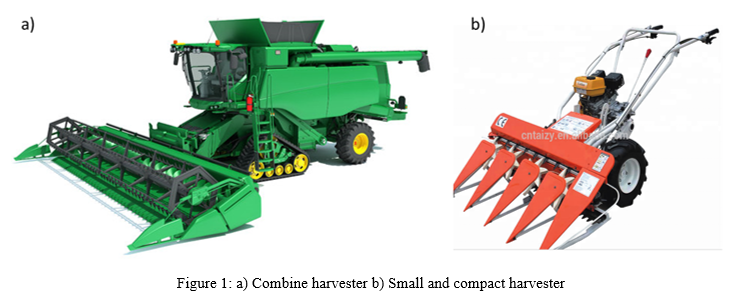
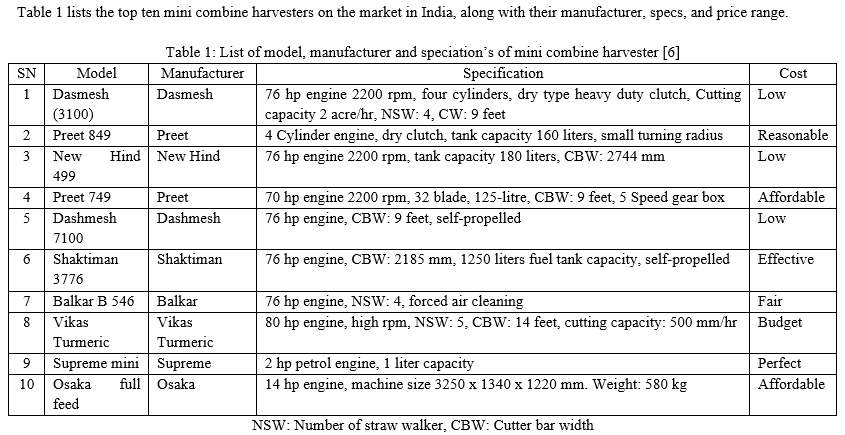
Minimizing energy consumption, as well as developing a resource-saving and environmentally friendly society, has been a major concern in today's globe in recent years. A rapid speed of modernization has also occurred in agricultural processes, resulting in greater mechanization of agricultural output. As a result, overall agricultural machinery power consumption has increased, resulting in higher energy consumption of agricultural production equipment [7][8]. Wheat and paddy has been cultivated in enormous areas all over the world as one of the world's primary food crops. As a result, there is a significant need for wheat and paddy harvesting machinery. As a result, reducing the energy usage of a wheat and paddy harvester would make a major contribution to lowering worldwide agricultural equipment carbon emissions.
A wheat and paddy harvester's cutting blade is an important component. Small cutting resistance and low energy consumption requirements of the cutting blade are greatly beneficial and contribute to total energy consumption reduction for a harvester machine, as the cutting process requires significantly large amounts of energy for harvesting. Wheat and paddy harvesters employ two types of blades in modern harvesters: rotary type and reciprocating type. Among these two blade types, rotary blades have a substantially greater share of research documented in the literature, with an emphasis on structural characteristics and blade motion parameters [9, 10]. The reciprocating cutting blade's blade configuration and motion parameter matching were the main topics of debate. It's worth noting that in this scenario, there's a lack of attention paid to blade construction characteristics [11]. Wheat and paddy harvesters now employ triangle tip tooth type reciprocating cutting blades. Cutting these stalks using a harvester blade results in high cutting resistance, high energy consumption, low stubble quality, and other difficulties. As a result, a new form of reciprocating cutting blade for cutting stalks is urgently needed.
Bionics, as a developing multidisciplinary area, offers academics new research ideas and methodologies for addressing a variety of issues, such as conserving energy and enhancing the quality of cutting instruments [12–15]. Insects and animals in nature have developed over millions of years as a result of battle for survival. Evolution has resulted in superior geometric structural optimization and efficient energy consumption, resulting in highly adaptive physiological features to the environment [16][17][18]. The use of bionics to apply animal biology as well as anatomy to farm equipment design has gotten a lot of focus in recent years. Bionics has been used to minimize drag and energy demand in the design of components for equipment such as openers, ploughs, and stubble rotary tillers [19].
Qaisrani et al. [20–22] used bionic concepts to develop an excavator and plowshare, respectively, by using convex hull shape of the mantis head and the beetle. According to a contrast test, the model was developed based on biomechanical principles resulting in a drag reduction ranging from 8% to 36%.
The structure and properties of the rat paw were used to construct a depth loosen shovel by Zhang et al. [23]. A hyperbolic function curve was used to build this bionic shovel. The bionic cultivation resistance of the deep loosening shovel was lowered by 8.5 percent to 39.5 percent in the comparison test. Similarly, Li et al. [9] constructed a bionic cutting blade based on the morphological properties of the mantis foot, which was shown to reduce both cutting force and energy usage by 23 percent when compared with conventional blade, and the impact of drag reduction was clear.
In this paper the blade was designed using the bionic principle and then analyzed using the Ansys software. The aim of this paper is to develop the new blade for the harvester and check its suitability in terms of deformation and stresses.
II. STAGES IN THE EVOLUTION OF A SMALL HARVESTER'S CUTTING BLADE
The harvesters are commonly used by the farmers. So, in order to develop the blade of the harvester, a genuine input can be obtained from the farmers. The authors have first contacted the farmers and interacted with them and gathered the difficulties which they are facing during the harvesting. In the second stage of development, the authors have contacted the local machine manufacturer and discussed the difficulties they are facing during the manufacturing of the blade. In the third stage of development the authors have gone through the internet search and gather the recent information of the harvesters. The stages of development of the blades are discussed in detail in below section.
A. Interaction with Local Farmer
Because the harvester is utilized by local farmers, it is critical to understand their needs and wants from the machine. Interaction with local farmers is a frequent way for determining their desires. The goal of the discussion is to find out what machinery they're using for harvesting, how much they cost, if it's possible for small-scale harvesting, which other conventional harvesting techniques they've employed, how much work they've spent, and so on. These queries will provide an overview of rural farming as well as farmer requirements and demands.
B. Consultation With A Machine Manufacturer In The Area
It is critical to speak with a local harvester producer to learn the fundamentals of harvester production. They should be questioned about the challenges they have in designing and manufacturing compact harvesters, how many goods they make for small scale farmers, and whether or not the company consults local farmers when developing new products.
C. Internet Search
With this research, you may see how much previous work on the very same topics has been published. Past data, such as Google patents, domestic and international journal and conference papers, can be utilized [24].
III. SELECTION OF BLADE FOR HARVESTER AND ITS DESIGN
The harvester currently uses two types of blades (Figure 2): reciprocating and rotating blades. When developing reciprocating blades for the harvester, greater emphasis was placed on motion parameters and structural design of the blade, whereas two crucial elements, namely shear stresses between two parallel blades and blade arrangement, were primarily considered. The authors came to know trough the consultation with farmers, interaction with the local harvester manufacturer and internet search that most of the harvester employs reciprocating blades in its construction.
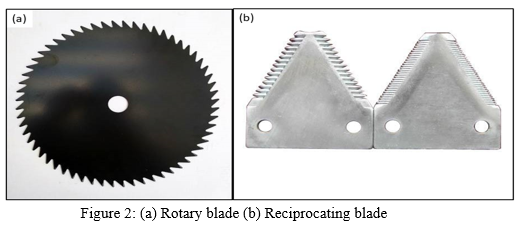
A. The Ordinary Blade Used In The Harvester
Harvester blades are the elements of the combine that scrape the surface of crops such as wheat, barley, corn, and other grains [25]. Iron and steel are perhaps the most prevalent materials utilized in the production of these blades. These blades are available from a variety of producers in the market, depending on the needs of their consumers. A cutting blade is an important aspect of a harvester's operation. Harvesters typically employ two types of blades: rotary blades and reciprocating blades. These blades have a triangle tooth shape that is commonly employed in the cutting of rice and wheat. A middle cutting member is sandwiched between an upper and a lower cutting member of a combine harvester blade, allowing the middle cutting part to cut crop such as rice. The top slicing member features many upper slicing blades, while the bottom cutting member reciprocates horizontally. The movement guide section and the movement limiting projection are also responsible for the most recent invention. It minimizes the reciprocating movement distance of the intermediate cutting section to cut more effectively. Figure 3 shows the blades which are commonly used in the harvester.

B. Methodology used in the Design of Blade.
Based on the problem identification, the literature review is carried out. In literature survey various papers from national and international journals were referred. Before designing the blade, the market survey was carried out. The problem was discussed with the farmers and there inputs and suggestions were taken into account. Based on the literature review and the inputs obtained from the local farmers the blade was design on the basis of bionic principle. The cutting force was obtained through the literature review. The analysis of blade was carried out with the help of ansys software. The stresses acting on the blade, total deformation and normal stresses was calculated for the ordinary blade and the developed blade. The comparison was done between the ordinary blade and developed blade. Figure 4 shows the flow chart of the methodology.
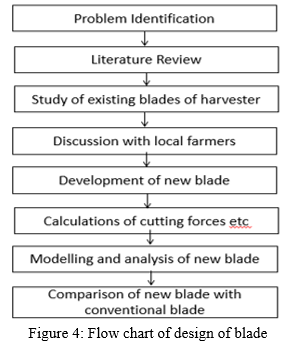
C. Design of Bionic Blade
The bionic blade employed the same base structural characteristics as the standard rice crop harvester blade to permit comparative study. The blade substrate's main structural properties were utilized to three - dimensional representation of the bionic blade in CATIA. The drafting image of ordinary blade is presented in figure 5.
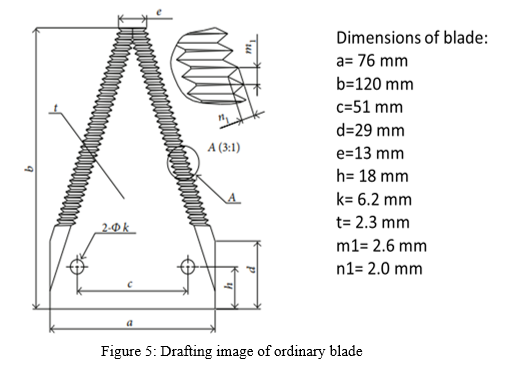
To guarantee that the cutter is strong enough to allow to reduce cutting reluctance, the gap was designed to run parallel to the blade cutting action. When comparing the two designs, as illustrated in Figure 4, the difference between regular and bionic blades becomes clear. The main reason for the variance is the tooth profile, pitch, and height. Figure 6 shows the drafting image of bionic blade.
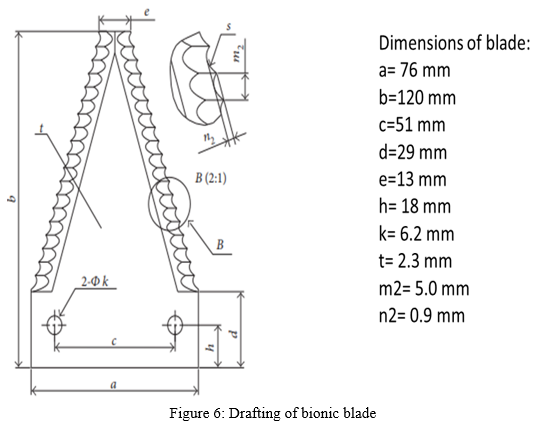
D. Material used for the blade
Iron and steel seem to be the most prevalent materials utilised in the production of these blades. These blades are available from a variety of producers in the market, depending on the needs of their consumers.
Table 2: Material and its properties (harvester blade)
|
Material |
Density (kg/m3) |
Tensile yield strength (MPa) |
Compressive yield strength (MPa) |
Tensile ultimate strength (MPa) |
|
Structural steel |
7850 |
250 |
250 |
460 |
IV. RESULT AND DISCUSSION
A. CAD Model of Blades
The blade was modelled in the CATIA software and then imported in Ansys software. Figure 7 shows the CAD model of ordinary and bionic blade.
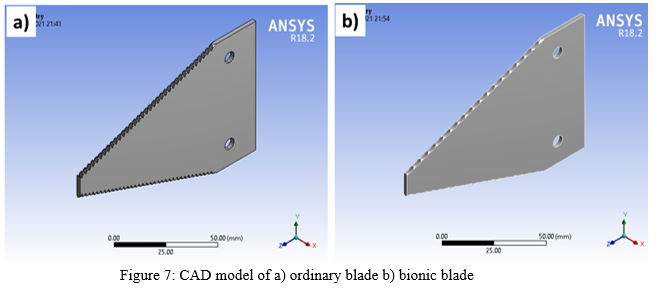
B. Meshing of Blades
After developing the CAD model of ordinary and bionic blade the meshing was done in Ansys software to carry out the analysis of the blade. Figure 8 shows the meshing of ordinary blade and bionic blade.
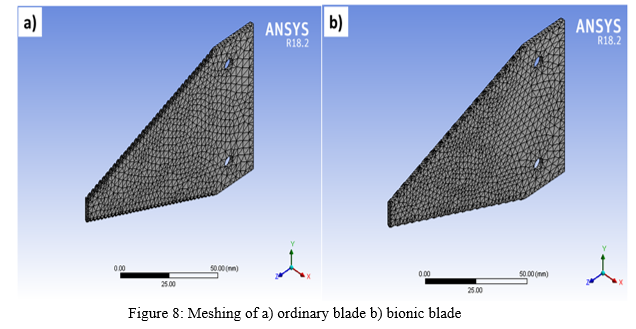
C. Equivalent Stresses on Blades
After meshing the blade, the boundary conditions were applied. The boundary conditions were applied by fixing the blade at the holes. After fixing the blades the force of 500N was applied to calculate the equivalent stress, normal stress and total deformation. Figure 9 shows the equivalent stress acted on the blades. The maximum equivalent stress acting on the ordinary blade was 32.96 MPa while the on the bionic blade 31.88 MPa.
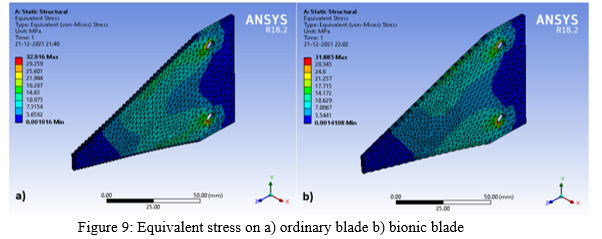
D. Normal Stresses on Blades
Figure 10 shows the normal stresses actin on the blades. The maximum normal stress acting on the ordinary blade was 9.05 MPa while on the bionic blade 8.76 MPa.
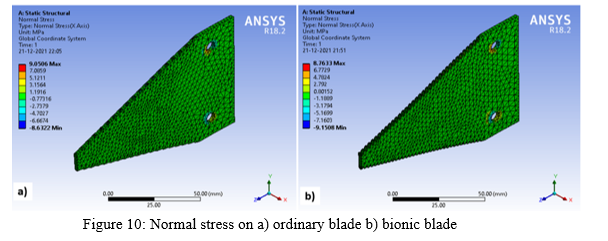
E.Total Deformation of Blades
Figure 11 shows the total deformation of the ordinary blade and bionic blade. The total deformation of the ordinary blade was 0.012 mm while the total deformation of bionic blade was 0.010 mm.
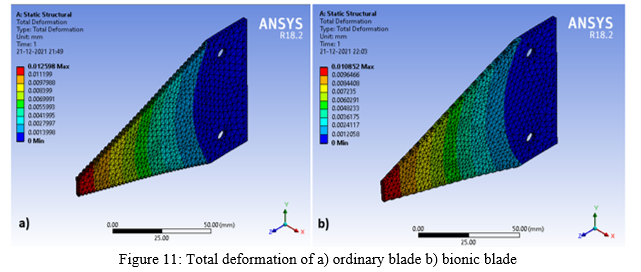
Table 3 shows the results obtained through Ansys software. The table shows the values of total deformation of the blades, equivalent and normal stresses acting on the blades.
Table 3: Results obtained after analysis of blade
|
Type of blade |
Total deformation (mm) |
Equivalent stresses (MPa) |
Normal stress (MPa) |
|
Ordinary blade |
0.0125 |
32.916 |
9.05 |
|
Bionic blade |
0.0108 |
31.883 |
8.76 |
Conclusion
In this paper, the new blade was successfully designed on the basis of bionic principle. 1) The equivalent and normal stresses acting on the blade was much more less than the tensile strength of the blade. 2) The equivalent stress acting on the bionic blade was less than the ordinary blade. The normal stress acting on the bionic blade was less that the ordinary blade. 3) The total deformation of bionic blade was less than the ordinary blade. It can be concluded that the bionic principle can be used in designing of the existing blade so as to improve its design in terms stresses and deformation.
References
[1] Raut, L. P.; Dhandare, V.; Jain, P.; Ghike, V.; Mishra, V. Design, Development and Fabrication of a Compact Harvester. IJSRD -International J. Sci. Res. Dev., 2014, 2 (10), 2321–2613 [2] Nadeem, M.; Lqbal, M.; Farooque, A.; Munir, A.; Ahmad, M.; Zaman, Q. Design and Evaluation of Self Propelled Reaper for Harvesting Multi Crops. Am. Soc. Agric. Biol. Eng. Annu. Int. Meet. 2015, 2015, 4 (July), 2855–2861. https://doi.org/10.13031/aim.20152189141 [3] Gadhave, V. S.; Gadsing, P. P.; Dike, Y. K.; Jaybhaye, A. S. Design , Development and Fabrication of Multi Crop Cutter Powered by Electric Motor. 2017, 6 (5), 104–112. [4] Petare, S.; Bawane, A. Design And Fabricate Crop Cutter Machine?: A Review Paper. 2021, No. 3, 1860–1864 [5] Raut, L. P.; Jaiswal, S. B.; Mohite, N. Y. Design, Development and Fabrication of Agricultural Pesticides Sprayer with Weeder. Int. J. Appl. Res. Stud., 2013, 2 (11), 2278–9480 [6] Gawande, A. P. R. R.; Kite, P. G. S. D. V; Lande, A. P. B. V. A Review on Compact Agricultural Harvester and Its Cutting Blade Geometries. Int. J. Sci. Res. Eng. trends, 2022, 8 (1), 448–454 [7] Igathinathane, C.; Womac, A. R.; Sokhansanj, S.; Pordesimo, L. O. Mass and Moisture Distribution in Aboveground Components of Standing Corn Plants. Trans. ASABE, 2006, 49 (1), 97–106. https://doi.org/10.13031/2013.20217. [8] Igathinathane, C.; Pordesimo, L. O.; Schilling, M. W.; Columbus, E. P. Fast and Simple Measurement of Cutting Energy Requirement of Plant Stalk and Prediction Model Development. Ind. Crops Prod., 2011, 33 (2), 518–523. https://doi.org/10.1016/j.indcrop.2010.10.015. [9] Li, M.; Chen, D.; Zhang, S.; Tong, J. Biomimeitc Design of a Stubble-Cutting Disc Using Finite Element Analysis. J. Bionic Eng., 2013, 10 (1), 118–127. https://doi.org/10.1016/S1672-6529(13)60206-1 [10] Raut, L. P. Computer Simulation of CI Engine for Diesel and Biodiesel Blends. Int. J. Innov. Technol. Explor. Eng., 2013, No. 32, 2278–3075 [11] Igathinathane, C.; Womac, A. R.; Sokhansanj, S. Corn Stalk Orientation Effect on Mechanical Cutting. Biosyst. Eng., 2010, 107 (2), 97–106. https://doi.org/10.1016/j.biosystemseng.2010.07.005 [12] Jia, H.; Li, C.; Zhang, Z.; Wang, G. Design of Bionic Saw Blade for Corn Stalk Cutting. J. Bionic Eng., 2013, 10 (4), 497–505. https://doi.org/10.1016/S1672-6529(13)60242-5 [13] Raut, L. P.; Taiwade, R. V. Microstructure and Mechanical Properties of Wire Arc Additively Manufactured Bimetallic Structure of Austenitic Stainless Steel and Low Carbon Steel. J. Mater. Eng. Perform., 2022. https://doi.org/10.1007/s11665-022-06856-8. [14] Patil, N. A.; Raut, L. P. VIBRATION ANALYSIS OF CI ENGINE USING FFT ANALYZER. Int. J. Res. Eng. Technol., 2005, 5 (1), 293–298 [15] Bhoyar, A. S.; Raut, L. P.; Mane, S. Total Productive Maintenance?: The Evolution in Maintenance and Efficiency. Int. J. Eng. Res. Appl., 2017. https://doi.org/10.9790/9622-0711012632 [16] Vincent, J. F. V.; Mann, D. L. Systematic Technology Transfer from Biology to Engineering. Philos. Trans. R. Soc. A Math. Phys. Eng. Sci., 2002, 360 (1791), 159–173. https://doi.org/10.1098/rsta.2001.0923 [17] Junior, W. K.; Cândido, L. H. A.; Marques, A. C.; dos Santos, S. S.; da Silva Viegas, M. Development of Junction Elements from Study of the Bionics. J. Bionic Eng., 2007, 4 (1), 41–46. https://doi.org/10.1016/S1672-6529(07)60011-0 [18] Zhang, Y.; Tian, H.; Huang, X.; Ma, C.; Wang, L.; Liu, H.; Lan, Y. Research Progress and Prospects of Agricultural Aero-Bionic Technology in China. Appl. Sci., 2021, 11 (21). https://doi.org/10.3390/app112110435. [19] Tawele, P.; Shinde, G.; Raut, L. Design and Development of 3-Way Dropping Dumper. Int. J. Emerg. Technol. Adv. Eng., 2014, 4 (9), 766–775. [20] Bulgakov, V.; Aboltins, A.; Beloev, H.; Nadykto, V.; Kyurchev, V.; Adamchuk, V.; Kaminskiy, V. Experimental Investigation of Plow-Chopping Unit. Agric., 2021, 11 (1), 1–14. https://doi.org/10.3390/agriculture11010030. [21] Zhang, J. B.; Tong, J.; Ma, Y. H. Simulation of Bionic Anti-Drag Subsoiler with Exponential Curve Feature Using Discrete Element Method. In Advances in Bionic Engineering; Applied Mechanics and Materials; Trans Tech Publications Ltd, 2014; Vol. 461, pp 535–543. https://doi.org/10.4028/www.scientific.net/AMM.461.535 [22] Raut, L. P.; Taiwade, R. V. Wire Arc Additive Manufacturing: A Comprehensive Review and Research Directions. J. Mater. Eng. Perform., 2021, 30 (7), 4768–4791. https://doi.org/10.1007/s11665-021-05871-5 [23] Li, M.; Yang, Y.; Guo, L.; Chen, D.; Sun, H.; Tong, J. Design and Analysis of Bionic Cutting Blades Using Finite Element Method. Appl. Bionics Biomech., 2015, 2015. https://doi.org/10.1155/2015/471347 [24] Ankush, A. N.; Raut, L. P. Design of Automatic Wall Plastering Machine. Int. J. Eng. Tech. Res., 2017, No. April, 543–548 [25] Shailesh Pachbhai, L. R. DESIGN AND DEVELOPMENT OF HYDRAULIC FIXTURE FOR MACHINING HYDRAULIC LIFT HOUSING. Int. J. Mech. Eng. Robot. Res., 2014, 3 (3), 1–14.
Copyright
Copyright © 2022 R. R. Gawande, D. V. Kite, B. V. Lande. This is an open access article distributed under the Creative Commons Attribution License, which permits unrestricted use, distribution, and reproduction in any medium, provided the original work is properly cited.

Download Paper
Paper Id : IJRASET41830
Publish Date : 2022-04-25
ISSN : 2321-9653
Publisher Name : IJRASET
DOI Link : Click Here
 Submit Paper Online
Submit Paper Online

